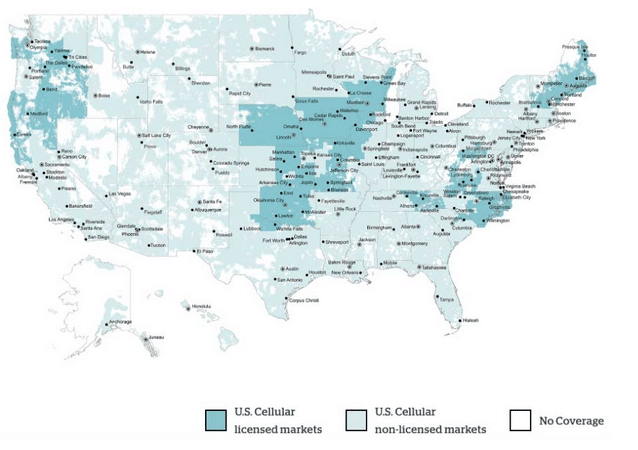Google Fi brought a lot of innovations and customer-friendly features to the wireless market. I’d argue that Fi’s biggest innovations have been in network switching. Subscribers using “Designed for Fi” phones can automatically switch between coverage from T-Mobile, Sprint, and U.S. Cellular’s networks.
Losing Sprint
Fi’s network switching is about to become a lot less interesting. Sprint’s network will disappear. U.S. Cellular doesn’t have a nationwide network.
The darker shade in the map below shows where U.S. Cellular’s network is available:1

U.S. Cellular’s network does not cover the majority of the U.S. Once Sprint’s network is gone, Google Fi will be a T-Mobile-based carrier in many places.2
T-Mobile’s network will get better as it integrates Sprint’s assets, so I don’t expect Fi to decrease substantially in quality. However, Fi may become a much less competitive option in comparison to other carriers. There are a lot of carriers that run over T-Mobile’s network. These carriers will also offer better performance as T-Mobile improves its network. Some carriers using T-Mobile’s network are priced much better than Fi. For example, Mint Mobile sells a plan with 8GB of data, unlimited minutes, and unlimited texts for as low as $20 per month. Fi would charge at least $70 per month for the same level of usage.3
I don’t mean to imply Fi will be left in the dust. The carrier offers high priority data, amazing international roaming options, and a user-friendly experience. Many low-cost, T-Mobile-based carriers don’t have those elements. Can Fi convince subscribers that Fi’s premium features justify the service’s price tag?
Will MVNOs get squeezed?
Low-cost carriers may get squeezed by T-Mobile. When Sprint goes offline, MVNOs will have fewer networks they can offer service over. The reduction in options may allow T-Mobile to increase the rates it charges carriers that use T-Mobile’s network.4 While low-cost carriers may have no option but to raise the prices charged to consumers, Fi may be better positioned. Fi is fairly expensive. It’s unlikely T-Mobile would charge Fi so much that Google would struggle to stay in the market.
Footnotes
- The map came from U.S. Cellular’s website on 7/8/20. There may be some discrepancies between the areas U.S. Cellular defines as a licensed market and the areas where U.S. Celluar’s native network is available. Note that U.S. Cellular’s own subscribers typically have roaming access on other networks when outside of U.S. Cellular’s network boundaries.
- Fi could end up with additional network partners, but I don’t see that as too likely anytime soon. I don’t think Verizon or AT&T would be excited to partner with Fi.
- There are lots of limitations to this comparison. Among other things, Fi charges for data by the megabyte. Mint allocates a fixed amount of data to subscribers each month.
- When trying to get regulators to approve the Sprint & T-Mobile merger, T-Mobile suggested it would take steps to keep the MVNO market vibrant. It’s not clear to me that T-Mobile was making these statements with sincerity. Time will tell.


When I used Fi it was rare to switch to the Sprint network, and since then the TMo network has improved greatly. Today on the East Coast it would be rare to find a spot that Sprint was better than TMo, but US Cellular does add significantly to coverage in places where TMo falls down, like way Down East Maine. Fi was always pricier than other MVNOs and was more about the features, like international roaming, than about coverage. Also, it is by far the easiest setup of any service and no need to haggle with awful store clerks. For someone like my father, who rarely leaves his home where he has Wifi, Project Fi is great and he can be on the plan that just charges for the data used. His usual monthly bill is less than $30, but he still has the data if he needs it for something.
I’m in east Tennessee. T mobile works in the city’s but jus barley outside the city it dosn’t. Sprint was better in The beginning but got worse it would show full bars but it wouldn’t work data or calls so it was jus a fake signal icon. US Cellular is byfar the best of the 3 but alot of times put me back on 3g. But 3g ain’t so bad anymore now that most aren’t using it anymore. EitherWay be nice to have verizon as one. Me and my wife have unlimited plans an we never go over 22gb even on vacay. They sorta capping you all the way cause you can disable the fi app and get stuck on whichever carrier you was on an it be a stronger signal. Def use this trick to get stuck on us cellular for days.
“The carrier offers high priority data….”
Do we actually know this? I have seen a lot of speculation online that supports this argument and just as much that refutes it. Google’s Fi FAQ and other materials do not make any claims to this effect, which makes me think it isn’t true. (if it was I assume they would at least mention it as it seems like a big selling point)
I am considering switching to Fi myself as if this is true it makes them just as good as the expensive post-paid carriers. (but again, I cannot find anything that confirms this)
Hi Aron,
I’m not sure Fi ever comes right out and says it offers high-priority data. I think the agreements carriers have with their host networks often prohibit sharing details like that. And I think you’re right to have some skepticism here. There are a lot of unsubstantiated, probably incorrect, claims about data prioritization floating around. That said, I feel reasonably confident that I’m correct about Fi. I ran a QCI test on Fi and found a QCI of 6. That’s the same QCI I found for data use on T-Mobile’s Magenta plan.
So – are we sure that Fi’s agreement does NOT include the T-Mobile towers/network? So, as TMo sunsets or absorbs the towers (I’m a current Sprint customer, and just got an email enticing me to come into the TMo (formerly Sprint) location nearest me to get a quick upgrade – I’m thinking it’ll be a new sim to access their 5G networks instead of Sprint’s)…
I’ve been considering a swap to Fi, but if the Fi agreement is dropping to just two carriers w/out TMo – that may make me change my mind…
Sorry for the confusion. Fi will keep T-Mobile as a partner, it’s Sprint that will disappear. As a result, Fi service may end up being awfully similar to T-Mobile service in areas where US Cellular doesn’t operate a network.
In my travels for work here’s what I’ve noticed on Fi using the cell mapper app. In sprint areas with no service, you roam on T-Mobile on bands 2,17, 41 as an extended network. In a sprint area with no T-Mobile service, you will be on band 25,26,41 and extended roaming on 2,17. Us Cellular is on Bands 2,4,5,and12 for Fi and in rare circumstances band 13 with VZW, however roaming is all on 3G and when that plug is pulled was projected as of this year.
Thanks Steve! That’s a lot of helpful context. For a while now, I’ve wished there was more easily accessible info out there about VZW roaming w/ Fi.
I’m thinking about switching to Verizon, I am stuck using T-Mobile at the parents house and my girlfriend can’t hear me. 😕
The coverage on Fi does not seem to be any different for me. I am in Western New York(No US Cellular). My question is now is there really a benefit to purchasing a built for Fi phone or is it the same now on an unlocked phone that works with tmobile since there is no network switching here in my area? My only complaint with Fi is very small selections of phones.
Probably not a big differences with most phones. Just watch out with iPhones. My impression is that while Fi allows them, there’s still some issues.
So, if I bought an Unlocked Motorola phone it should work exactly the same as a built for fi phone in my area with no US Cellular? I would like to buy the Moto G100, but it’s not on Fi and I don’t want to sacrifice coverage to get the phone.
I wouldn’t quite put it that way. In the short term, Designed for Fi phones might still be using Sprint’s legacy network until it’s fully decommissioned.
Further, if you’re going to use a phone that’s not “Designed for Fi” it’s still important that the phone is well-matched for T-Mobile’s network [I should have made this clearer in my previous comment]. I don’t think the G100 supports band 71 (used for T-Mobile’s extended range LTE). That doesn’t mean the phone won’t work decently with T-Mobile, but it’s not the optimal situation if you’re looking for great coverage.
Current Fi user, since 2016. Happy with coverage except deep rural areas. Point of clarification please. I’m of the understanding that Sprint’s network is not being decommissioned, per se, but rather converted and absorbed into T-Mobile. So the sum of the whole will still be better coverage than for T-Mobile or Sprint as it exists today / yesterday?
Although, looking at my Signal Spy history I haven’t seen a Sprint connection since May 9th. Are my Sprint expectations misguided? US Cellular is appearing to be used much more frequently, and WiFi calls have been nonexistent on my LG G7 ThinQ
Hi Bruce, your understanding is right. Sprint’s assets are getting merged into T-Mobile’s network. In some cases, Sprint’s hardware will be totally decommissioned, but lots of stuff will be repurposed for the New T-Mobile’s use.
I recently pre-ordered a Google-Fi Pixel 6 Pro (mostly because the carrier pre-orders were all sold out. I figured I could just activate the Fi Pixel on my T-Mobile account – is that accurate or will I need a handset designed for T-Mobile?
The phone will have all the hardware needed for T-Mobile. I believe all of Fi’s phones come unlocked, so I think you should be fine. Here’s a bit from one of Fi’s FAQs:
“Any device you get from Google Fi comes unlocked and can be used with other wireless providers if you choose to leave our service.”
Crap coverage at the house in the last month or two.. Looks like T-Mob is killing my sprint tower.